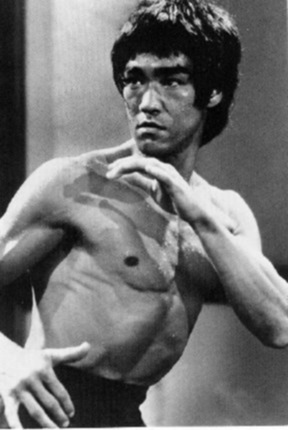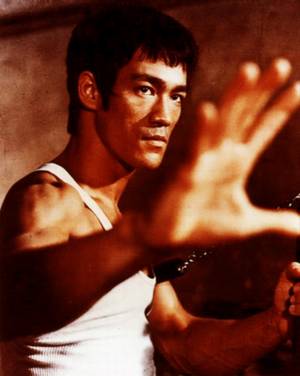|
Bruce LeeBruce Lee – Learn about the man and the legend - history, approach to martial arts….
Bruce Jun Fan Lee – 1940-1973 – Bruce Lee was not just a movie star. He was true a martial artist, who dedicated himself to investigating the martial arts world – from technique through physical to philosophy he explored and searched for information that would help him improve and refine his abilities and understandings. His rise to stardom was the rise to stardom of and for all the martial arts, for he popularized them in every western world house hold. Learn more about Martial Arts Masters who popularized the martial arts Brief HistoryBruce was born in San Francisco, while his father (who was an actor) was touring the United States with a Cantonese stage company. The family decided to return to Hong Kong, only to live a rough three years under Japanese occupation. Due to poor academic achievements and perhaps also poor conduct he was transferred to another school were he was taught by a Catholic monk who happened to be the high school boxing coach. At the age of 17 he won “High School Boxing Championship” of Hong Kong – winning his first three opponents by knockout in the first round, and the 3 time reining champion with a knockout in the third. Bruce’s first introduction to the martial arts was made through his father who taught him the fundamentals of Wu style Tai Chi he continued his studies for some time Wu Ta-chi a well known and respected teacher in Hong Kong His next introduction to the martial arts was through Wing Chun’s grandmaster Yip Man and his senior student Wong Shun Leung. After being beat up by a gang in a street fight e was taken to Yip Mans school at the age of 13 by friend William Cheung (later to become a well known teacher of Wing Chun as well). His training of with Yip Man and Wong Shun Leung was interrupted at the age of 18 when he was sent back to the United States. Lee also learned some western fencing from his older brother Peter Lee who was a champion fencer. All this exposure to different martial arts expanded his understandings and abilities and shaped his eclectic approach to this world – never wanting to limit himself in thinking and perception. At the age of 14 he took up Cha-Cha dancing eventually winning the Crown Colony Cha-Cha Championship at the age of 18; Showing his move for movement, timing and coordination as well as his deep desire to be the best. After participating in one street fight to many (apparently the last fight was against an under world connected person, and a contract was made on Bruce) his parents decided to send him to the States so that he will keep out of trouble and expand his studies. Upon his leaving Bruce Lee had already participated in many Hong Kong films due to his father’s relationship with the industry. Life in the United States: In December 1960, when living in Seattle, Lee graduated and got his high school diploma.He then enrolled in the University of Washington majoring in drama; it was there he would meet his future wife Linda Emery, who he would marry in 1964. He and Linda would have to children before his unexpected death – Brandon Lee (1965-1993) and Shannon Lee (1969 - ) During his years in Seattle, Bruce taught the martial arts. He taught Jun Fan Kung Fu (Jun Fan being his Chinese name). This system was a slightly modified version of the Wing Chun which he learned in Hong Kong. One of the major difference was the emphasis he put on kicking, which although using the “straight forward no loading” striking method of Wing Chun utilized kicks which were not in the “Wing Chun repertoire”. Another major difference was the fact that he changed the training methods that were implemented in the Wing Chun system (To learn more about Systems in the Martial Arts….) In 1962 Lee met Wally Jay a Jujitsu instructor which introduced him to the system and contributed to his general understanding in the martial arts and to the soon to come creating of Jeet Kune Do. Jesse Glover was his first student and later became his first instructor when Lee opened his first school in Seattle. Bruce moved to Oakland before finishing his college degree and opened another Jun Fan school. He left his good friend and student Tamy Kimura as lead instructor in Seattle. It was because of this school that he was challenged in 1965 by Wong Jack Man to fight over the right to teach in the area – who ever would lose would have to close his school. Bruce won but, in his mind, it took him too long… Jeet Kune Do This was the final insensitive for the formation of Jeet Kune Do – The Way of the Intercepting Fist. He felt that the traditional martial arts were not suited enough for the chaotic street fights, and set out to form a “style without style” so that a practitioner could adapt to any fighting situation easily. He used training methods which were unorthodox at the time for kung fu trainings such as running, weight lifting and other methods some which he invented. Starting from 1964 Bruce was invited to give open demonstrations of his skills and abilities. It was in these demonstrations where he demonstrated his physical skills such as one handed two finger push ups, and technical abilities like the “inch punch”. In 64 he also met Ed Parker, who is considered to be the “Father of American Karate” - Kenpo. This meeting would lead to his famous demonstrations in the Long Beach International Karate Championship in 64 and 67, and shows once again his openness and eagerness to learn, teach and exchange information, thoughts and skills with any martial art. Film career re-launched Bruce’s first acting part came in 1966 as he played Kato the Green Hornets side kick in the one season series “The Green Hornet”. This re-launched his acting career. After many supporting roles, in 1971, and after moving to Hong Kong, he appeared in his first lead role in Raymond Chows “Golden Harvest” production the “The Big Boss” (released as “Fists of Fury” in the U.S.) - this role launched him into instant stardom. It was soon followed by “Fist of Fury” (released in the U.S. as the “The Chinese connection”) in 1972. Way of the Dragon ( “Return of the dragon” as named known in U.S.) was released the same year. In 1973 “Enter the Dragon” was released. It was a joint production with Warner Bros. and Golden Harvest making it an international success. However Lee did not live to see this films success as he died from hypersensitivity to the muscle relaxant in “Equagesic” – a medication he took after suffering from a headache. His death was ruled “death by misadventure”. Before his death Bruce begun working on the film “Game of Death” this film was released in 1979 using a look a like and archive footage.
Legacy:Maybe one of the most appealing characteristics about Bruce Lee was his “logical and quality based judgment” approach towards anything which had to do with his martial art development. In this way the “Warriors Project” is much the same. He was open-minded to any information or knowledge which could help him improve and refine his skills and abilities. Bruce had countless books, on anatomy, psychology, philosophy, physiology nutrition and more. He tried whatever seemed logical in his training regime, and kept what worked. He understood, that a martial art should “work” for him and not the other way around. A martial art should enable him to utilize his physical and mental advantages (To learn more about the Theory of a Martial Art…). Lee used weight training, running, cycling, skipping rope as well as traditional methods like thrusting his hands into rocks and gravel to make his skin more durable or using a wall bag to strengthen his punching structure. He tried using food supplements, as well as keeping a well planned diet, while still using Chinese medicine.
Notable StudentsLike any teacher or instructor – one is judged by the quality of his student’s abilities and stature not only by his own (To read more about teachers and instructors in the martial arts) • Dan Inosanto – certified by Bruce to teach Jeet Kune Do • Taky Kimura - certified by Bruce to teach Jeet Kune Do • James Yimm Lee - certified by Bruce to teach Jeet Kune Do • Brandon Lee • Ted Wong • Jesse Glover • Larry Hartsell • Much more Important Books• Chinese Gung-Fu: The philosophical Art of Self Defense – written by Bruce. • The Tao of Jeet Kune Do – published after his death based on his notes. • Bruce Lee’s Fighting Methods – published after his death based on his notes. Books about Bruce: • Bruce Lee: The Man Only I Knew • Bruce Lee Between Wing Chun and JKD (Jeet Kune Do) • Striking Thoughts – quotes and thoughts of Bruce Lee • Much More Movies• The Big Boss • Fist of Fury • Way of the Dragon • Enter the Dragon • Game of Death • Over twenty films which he played in during his childhood days in Hong Kong Documentaries: • Bruce Lee: A Warrior’s Journey • Bruce Lee, the Legend • Curse of the Dragon • The Intercepting Fist • Much More Biographical films: • Dragon: The Bruce Lee Story • More are in productions Fighting Philosophy and SpiritBruce Lee was an eclectic martial artist, taking training ideas, information and methods from any source he could, without limiting himself by tradition or bias. Bruce was an atheist but was deeply influenced from Buddhism, Zenisim, Taoism and more. He was influenced from books such as “The Art of War” by Lau Tzu and watched countless hours of Muhammad Ali’s fights. Quotes: “Use only that which works, and take it from any place you can find it” “All kind of knowledge, eventually becomes self knowledge” “Be formless, shapeless, like water. If you put water into a cup it becomes the cup. If you put water into a bottle, it becomes the bottle. You put it into a teapot, it becomes the teapot. Water can flow and it can crash… Be water my friend…” ConclusionBruce Lee was a fighter in spirit and in practice. More then anything he devoted himself to self improvement and refining himself and his martial art abilities. His open mindedness is an attribute well worth adopting and applying. It is a shame we could not see him reach the martial art heights he could have risen to. Many martial artists today recall the “Bruce Lee phenomena” as having an influence in their martial art path. For that and much more Thank you
Return to Martial Arts Masters Return from Bruce Lee to Homepage
|


